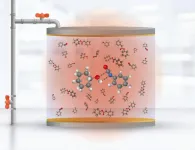(Press-News.org) As the body ages, organ function progressively declines and the risk for a wide range of diseases, including cardiovascular disease, cancer and neurodegenerative diseases, increases. Understanding how the body ages is an intense area of research as it will potentially illuminate ways to promote healthy aging.
Researchers at Baylor College of Medicine, Chan Zuckerberg Biohub San Francisco, Genentech, Inc. and collaborating institutions are breaking a path in that direction. They report in the journal Science, the first Aging Fly Cell Atlas (AFCA), a detailed characterization of the aging process in 163 distinct cell types in the laboratory fruit fly. Their in-depth analysis revealed that different cell types in the body age differently, each cell type following a process involving cell type-specific patterns. AFCA provides a valuable resource for researchers in the fruit fly and aging communities as a reference to study aging and age-related diseases and to evaluate the success of anti-aging strategies.
“Research has shown that, for instance, some cells like neurons in the brain live longer than cells in the gut lining, which are replaced by new ones often,” said co-corresponding author Dr. Hongjie Li, assistant professor of molecular and human genetics and the Huffington Center on Aging at Baylor. He is also a member of Baylor’s Dan L Duncan Comprehensive Cancer Center. “Our team is interested in better understanding how different cell types age differently, and to that end, we analyzed in detail several biological characteristics of individual cell types as fruit flies aged naturally in the lab. The fruit fly is a well-known model to study human conditions. About 75% of genes associated with human diseases have functionally similar counterparts in the fly.”
Dr. Stephen Quake, the Lee Otterson Professor of Bioengineering and Applied Physics at Stanford University and co-corresponding author of the Science paper, said the new atlas provides a powerful, open-access resource for scientists to better understand the biology of aging. “Through a highly productive collaboration, our team has created an exceptionally detailed map of how gene expression changes with aging across a wide range of cell types in the fly,” said Quake, also head of science at the Chan Zuckerberg Initiative (CZI). “Since a majority of these genes have similar roles in people, this dataset offers a unique vantage point to begin to decipher why many serious human diseases emerge in later life.”
As the flies aged, the researchers took samples when the animals were 30, 50 and 70 days old (the latter is equivalent to an 80-year-old person). At each time point, the team conducted single-nucleus RNA sequencing to analyze gene expression changes in individual cells in different organs and compared the results to those of young flies (5 days old). The team examined four different aging features: cell composition changes, number of differentially expressed genes, change in the number of expressed genes and decline of cell identity. They found that as flies age, these features change as a group according to cell type-specific patterns.
“We found that aging impacts cellular composition across the whole fly,” Li said. Fat body cells were among the cell types that increased in number the most, while muscle cells decreased the most. Neurons, however, did not show major changes in the number of cells during the fruit fly’s life. “In addition, the analysis of the genes expressed by different cell types in time revealed that fat cells show the largest difference between the number of genes expressed in young versus old fruit flies,” Li said.
The researchers also found that about 80% of all the cell types analyzed decreased the number of genes expressed, and 20% increased this number. “We plan to study the mechanism of this observation in the future,” said co-first author Dr. Tzu-Chiao Lu, postdoctoral associate in the Huffington Center on Aging.
The team also investigated whether cellular gene expression programs that define cell identity change as the animals age. “For example, compared to the flight muscle identity marker Nig1 in young flies, the marker in older flies is dramatically decreased, while other markers began to appear as the flies grew older,” Li said.
“We have learned that each of the four aging features we studied measures a different aspect of the cell and that not a single feature applies to all cell types,” Li said. “Combining all aging features led us to discover unique cell type-specific aging patterns and comparing them revealed useful and interesting findings. For instance, neurons in the brain age slowly, while muscle, fat and liver cells age much faster. Also, cell-type specific aging patterns may vary according to gender.”
“A critical observation of this study is that cell type-specific aging patterns in cells can be used to gauge biological age, that is the relative aging status of an organism, independent of its chronological age,” said co-corresponding author Dr. Heinrich Jasper, principal fellow at Genentech Inc. “This will provide further insight into factors, such as diets, drugs and diseases, that may change the aging trajectory and hence make an organism ‘younger’ or ‘older’ than its chronological age.”
“We hope that researchers will explore the possibilities AFAC offers to a variety of scientific fields, including genetics, cell biology and physiology,” Li said. The team has developed a user-friendly data portal and provide access via CZI’s CELLxGENE platform. All resources can be accessed at https://hongjielilab.org/afca.
For the complete list of all the authors, their affiliations and financial support for this work, see the publication.
###
END
Close up on aging reveals how different cell types in the body age at different pace
2023-06-15
ELSE PRESS RELEASES FROM THIS DATE:
A new path for quantum physics to control chemical reactions
2023-06-15
Controlling chemical reactions to generate new products is one of the biggest challenges in chemistry. Developments in this area impact industry, for example, by reducing the waste generated in the manufacture of construction materials or by improving the production of catalysts to accelerate chemical reactions.
For this reason, in the field of polariton chemistry - which uses tools of chemistry and quantum optics - in the last ten years different laboratories around the world have developed experiments in optical cavities to manipulate the chemical reactivity of molecules at room temperature, ...
Light Pollution Special Issue
2023-06-15
Light pollution is increasing around the globe, both in its intensity and geographic extent. Researchers are documenting its impact on ecosystems, human health, and culture, while warning that the wasted light has financial costs, environmental impacts, and is responsible for substantial greenhouse gas emissions. In a special issue of Science, five papers discuss the growing adverse impacts of light pollution, along with the regulatory and technological solutions that could help mitigate its effects.
Artificial ...
Aging fly atlas reveals cellular-level view of aging over the life of a model organism
2023-06-15
Tzu-Chiao Lu, Maria Brbic and colleagues have completed the Aging Fly Cell Atlas, a single-nucleus transcriptome map of the Drosophila melanogaster fly as it ages. Aging is known to be a risk factor for many diseases across many animals including humans, but understanding how the process affects cell composition and different cell types is still mostly unknown, making the new atlas a valuable reference in further studies. Lu et al. used single-nucleus RNA sequencing to generate the Fly Cell Atlas that profiles ...
Massive eruption of Ontong Java Plateau is younger than previously thought
2023-06-15
New high-precision argon isotope dating of the Ontong Java Plateau indicates that it is 10 million years younger than previously thought, according to Peter Davidson and colleagues. The Ontong Java Plateau is part of a massive underwater volcanic eruption – possibly the largest in Earth’s history – that took place in the Cretaceous Period in the equatorial western Pacific Ocean. This huge igneous emplacement has been proposed as the cause of Ocean Anoxic Event (OAE) 1a – a short period of severely reduced oxygen in the ocean - but the new dates for the eruption suggest it happened after OAE 1a. Some researchers ...
Cleaner air with a cold catalytic converter
2023-06-15
The so-called three-way catalytic converter in the exhaust system of a car consists of expensive materials and only works correctly when the exhaust gases have a temperature that is several hundred degrees Celsius.
As a result, when you start your car, or when you drive a hybrid car in which the petrol engine and electric motor alternate between driving the powertrain, the gases leaving the exhaust still contain toxic carbon monoxide. In a new Science article, scientists led by Emiel Hensen now show that by modifying the carrier material of the catalyst, it is possible to almost completely convert toxic carbon monoxide into carbon dioxide gas even at room temperature.
Noble ...
Illusions are in the eye, not the mind
2023-06-15
Numerous visual illusions are caused by limits in the way our eyes and visual neurones work – rather than more complex psychological processes, new research shows.
Researchers examined illusions in which an object’s surroundings affect the way we see its colour or pattern.
Scientists and philosophers have long debated whether these illusions are caused by neural processing in the eye and low-level visual centres in the brain, or involve higher-level mental processes such as context and prior knowledge.
In the new study Dr Jolyon Troscianko, from the University of Exeter, co-developed a model that suggests simple limits to neural responses – not deeper ...
If art is how we express our humanity, where does AI fit in?
2023-06-15
The rapid advance of artificial intelligence has generated a lot of buzz, with some predicting it will lead to an idyllic utopia and others warning it will bring the end of humanity. But speculation about where AI technology is going, while important, can also drown out important conversations about how we should be handling the AI technologies available today.
One such technology is generative AI, which can create content including text, images, audio, and video. Popular generative AIs like the chatbot ...
NCCN convenes policy summit assessing impact of geography on cancer outcomes, examining rural and urban divide
2023-06-15
WASHINGTON, D.C. [June 15, 2023] — Today, the National Comprehensive Cancer Network® (NCCN®)—an alliance of leading cancer centers—convened a policy summit to examine how geography impacts cancer outcomes.
NCCN Chief Executive Officer, Robert W. Carlson, MD, opened the event with a focus on equity.
“NCCN’s work is guided by the idea that where you live should not impact whether you live,” said Dr. Carlson. “NCCN Guidelines are one free resource to make sure everyone, everywhere, has access to cancer care based on the latest evidence ...
Shaping the future of medicine: Redox Science takes center stage at the International Conference of Redox Medicine Society in Paris
2023-06-15
Paris is set to host the highly anticipated 25th International Conference of the Redox Medicine Society, where global leaders and experts from the field will converge to unveil groundbreaking advancements and shed light on the future of Redox Medicine. Taking place from June 21 to June 23, the conference will feature over 61 dynamic communications, including major presentations, short talks, and poster sessions, showcasing the latest research and discoveries in the field of redox reactions, oxidative stress, and their profound ...
New, precise, and efficient DNA sequencing method may lead to easier testing and earlier cancer detection
2023-06-15
PHILADELPHIA – Researchers from the Perelman School of Medicine at the University of Pennsylvania have invented a new way to map specific DNA markings called 5-methylcytosine (5mC) which regulate gene expression and have key roles in health and disease. The innovative technique allows for scientists to profile DNA using very small samples and without damaging the sample which means it can potentially be used in liquid biopsies (testing for cancer markers in the bloodstream) and early cancer detection. Additionally, unlike ...




